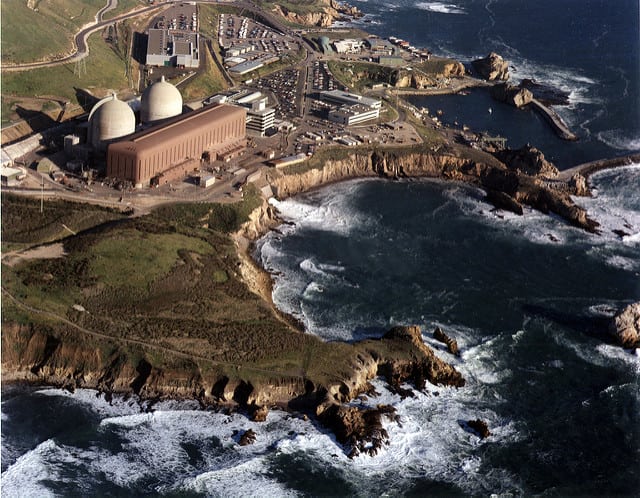PG&E Moves to Retire 2.3-GW Diablo Canyon Nuclear Plant
 Diablo Canyon Nuclear Power Plant, Units 1 and 2, which are located near Avila Beach, Calif. Courtesy: Pacific Gas and Electric.
Diablo Canyon Nuclear Power Plant, Units 1 and 2, which are located near Avila Beach, Calif. Courtesy: Pacific Gas and Electric.Diablo Canyon, the two-reactor nuclear power plant on the central California coastline, will be permanently shuttered by 2025 under a renewables-boosting initiative announced today by its owner, Pacific Gas and Electric (PG&E).
The company on June 21 unveiled a "joint proposal" with labor and environmental groups that seeks to increase investment in energy efficiency, energy storage, and renewables beyond current state mandates, while also phasing out nuclear power in California by 2025.
A 2015 state law requires California to source 50% of its power from renewables by 2030. California's energy storage mandate, meanwhile, calls for the state's three big investor-owned utilities to procure 1.3 GW of energy storage over the coming decade. It also recently doubled energy efficiency goals, and it has championed Community Choice Aggregation, a state policy that enables local governments to aggregate electricity demand within their jurisdictions to procure alternative energy supplies while maintaining services from an existing transmission and distribution provider.
Replaced with "GHG-Free Portfolio"
But these new energy policies will "significantly reduce the need for Diablo Canyon's electricity output," PG&E said on June 21.
Among the factors contributing to its decision to shutter the nuclear plant are "the challenge of managing over-generation and intermittency conditions under a resource portfolio increasingly influenced by solar and wind production, the growth rate of distributed energy resources, and the potential increases in the departure of PG&E's retail load customers to Community Choice Aggregation," it said.
The joint proposal seeks to replace power produced by Diablo Canyon's two units-which together have an installed capacity of 2.3 GW and provide nearly 10% of all power generated in California-with renewables, energy efficiency, and energy storage. "It includes a PG&E commitment to a 55 percent renewable energy target in 2031, an unprecedented voluntary commitment by a major U.S. energy company," the company said.
But it also noted that procurement, construction, and implementation of its planned "greenhouse gas-free portfolio" will "take years." That's why it plans to operate the nuclear plant units until operating licenses granted by the Nuclear Regulatory Commission (NRC) expire.
Unit 1 will be retired on November 2, 2024, and Unit 2 on August 26, 2025.
However, it noted, the proposal is contingent on a number of regulatory actions, including approval of a lease extension from the State Lands Commission. Without that extension, the plant may not operate beyond 2018.
It also needs the California Public Utilities Commission to approve its power replacement plan. "Any resource procurement PG&E makes will be subject to a non-bypassable cost allocation mechanism that ensures all users of PG&E's grid pay a fair share of the costs," the company noted.
Plagued by Controversy
The news is a pronounced concern for California's reliability gatekeeper, the California Independent System Operator, which on Monday issued a Flex Alert for Southern California in a bid to prevent rolling blackouts. The call for consumers to conserve electricity was issued due to high temperatures in the region.
But the decision was widely lauded by environmental and citizen groups. Public opposition to the plant, a former POWER Top Plant, has mounted since the Fukushima disaster in 2011, owing to the plant's oceanside location in San Luis Obispo County, Calif. Democratic lawmakers from the state have pointed out that Diablo Canyon is the nation's only nuclear plant operating at the highest seismic risk area as determined by the Nuclear Regulatory Commission. PG&E has countered that the facility is seismically safe and able to withstand the largest potential earthquakes in the region.
The announcement is also a new setback for the battered U.S. nuclear power sector: The reactors' closure will be the 13th and 14th announced nationwide since October 2012.
Low natural gas prices, market conditions, and technical issues have already precipitated five reactor closures well ahead of planned lifetimes: Kewaunee, two units at San Onofre, Crystal River, and Vermont Yankee.
Meanwhile, Entergy has also announced plans to close its 852-MW FitzPatrick reactor in New York state by January 2017. Exelon Corp. last year announced it would shutter its Oyster Creek plant in New Jersey in 2019, about 10 years before its current operating license ends, to avoid costs associated with the Environmental Protection Agency's cooling water rule. Entergy's 677-MW Pilgrim reactor in Massachusetts will also be closed in 2019, owing to market conditions.
Just last week, the Omaha Public Power District voted unanimously to close Fort Calhoun Station, the smallest nuclear power plant in the U.S., due to economic reasons. And earlier this month, Exelon said it would begin steps to permanently shut down the Quad Cities and Clinton nuclear power plants, citing a lack of progress on Illinois energy legislation that would have saved the two plants.
-Sonal Patel, associate editor (@POWERmagazine, @sonalcpatel)
The post PG&E Moves to Retire 2.3-GW Diablo Canyon Nuclear Plant appeared first on POWER Magazine.